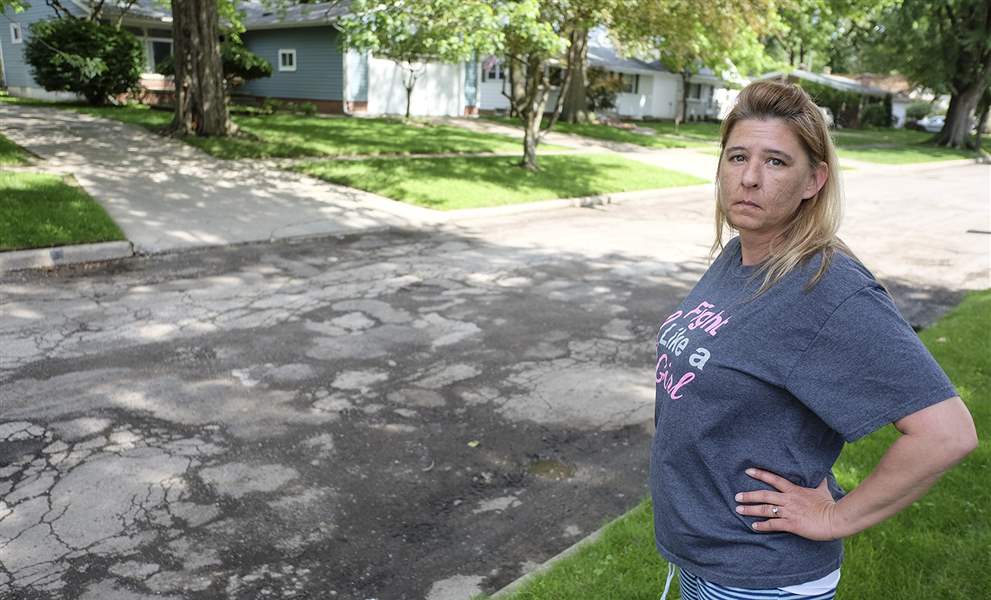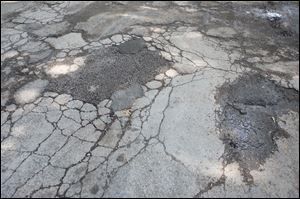
A BLADE SPECIAL REPORT
Residents fume as streets crumble around Toledo
Public grows weary of piecemeal approach to repairs
6/21/2015
Patty Hindall, a resident of Clover Lane in West Toledo for 14 years, says her husband often calls the city about potholes. Patch crews recently needed to repair cracks and potholes that were forming where some driveways met the street, but she says she would like to see her street completely resurfaced.
THE BLADE/JEREMY WADSWORTH
Buy This Image
The potholes, cracks, bumps, and loose stones are piling up in Toledo’s streets, and the damage is spreading to driveways, cars, and even homes.
After seven years of revenue cuts and two severe winters, Toledo’s pavement is showing the effects of neglect.
PHOTO GALLERY: Click here to begin slideshow
And city residents are not afraid to point it out.
City officials estimate a repair backlog of $1.3 billion but a budget for resurfacing and reconstructing distressed roads of only $19.5 million, according to Doug Stephens, commissioner of Toledo’s Engineering Services.
The Blade asked Toledo residents to send reports of damaged streets. Dozens of calls and emails came in from frustrated residents nominating roads all over the city. The Blade reporters visited all of the streets to see the damage firsthand.
At the intersection of Orchard Hills Boulevard and Valley Stream Road in South Toledo, the roads are especially patchy.
“It seems like every spring they try to patch up different spots,” said resident Bob Wurst, who has lived on the street for 44 years. The repairs do little to alleviate the bumpy ride. “It’s like you’re on a roller-coaster ride,” he said.
Mr. Wurst said he knows a mechanic who brings vehicles to Orchard Hills to check for any rattles, which are sure to occur on the irregular street.
“I hear things rattling in my own car that I never heard before,” he added.
City officials have blamed the crumbling streets on a series of problems, beginning with the 2008 Great Recession that led to cuts in the city’s income tax revenues and in local government revenues from the state.
To maintain critical city services, city officials in 2010 and 2012 got voters to approve a change in how the 0.75 percent temporary income tax is spent, authorizing the one-third that was earmarked for capital improvements to be spent on daily operations.
The city has never used the approximately $17 million that is available, but since 2010 has transferred between $5.5 million and $14 million a year from capital improvements. A transfer of $11 million is planned for this year. The transfers would decline over the next few years, to $5 million in 2019, and then to zero in 2020, according to city Finance Director George Sarantou.
But even if the city succeeds in weaning itself from using capital funds in the general fund, the total capital budget is still projected to decline from $61.3 million in 2015 to $48.1 million in 2019.
The rising backlog of deteriorated streets has become an issue in the special election for mayor on Nov. 3.
The three major candidates — Mayor Paula Hicks-Hudson, former University of Toledo vice president for administrative services Sandy Drabik Collins, and former Mayor Carty Finkbeiner, who is officially undeclared — have said the city must stop using capital improvement funds to pay for ongoing procedures. None of them has spelled out a specific plan to immediately bring that borrowing to a halt.
‘More fed up’
The residents of Clover Lane in West Toledo have sought a long-term solution to the potholes. The damage extends to the very edges of the road.
Heather McKinney has known Clover Lane for a long time. She took over the house from her grandmother, who had been living there since 1954, in 2000. Ms. McKinney said the damage to the road is steadily getting worse.
“It’s always been a problem,” Ms. McKinney said about the potholes in the road. “I’m just getting more fed up with it.”
Ms. McKinney said she “calls all the time” to have the city patch the potholes.
She’s not the only one. A few houses down, Patty Hindall, a resident of Clover Lane for 14 years, said her husband often calls about the potholes. Mrs. Hindall said patch crews recently needed to repair cracks and potholes that were forming where some driveways met the street.
Mrs. Hindall doesn’t want another temporary fix. She said she would like to see her street completely resurfaced.
Many problems
Darlene Harder of Martin Avenue wants a new road too. In the 55 years that Ms. Harder has lived on Martin Avenue, she cannot recall her road ever being resurfaced.
The patchwork street has caused many problems for Ms. Harder, who will turn 81 in July. Ms. Harder said her basement has flooded three times, and debris from the road washes up onto her front lawn after heavy rain.
“The house vibrates when people drive by,” Ms. Harder said. She called the condition of the road “very poor” and added, “I’m too old to move on. I’m stuck here.
“I don’t know how they choose streets,” Ms. Harder said of the city. “And I pay taxes, I should get a little bit of something done.”
The system
The system used by the Division of Engineering Services to determine which streets need resurfacing or reconstructing is “good, but not perfect,” Mr. Stephens said.
He said the city first processes complaints of residents and then looks at the rating of the roads on their pavement condition rating index. For a residential road, the city also looks at traffic loads and maintenance records.
“Money is a large driving factor,” he added.
Mr. Stephens said it costs about $500,000 a mile to resurface an average residential road that is 24 feet wide. Reconstruction of a road, which involves working on the base of the street, rather than just the top layer of asphalt, costs $1.5 million per mile.
The city will have $4.4 million for resurfacing and reconstructing residential roads, and $7.3 million for projects on major roadways such as the Anthony Wayne Trail in 2015, Mr. Stephens said. The city received an additional $7.8 million in grants for the major projects.
“There’s no federal or state money given for residential projects,” he said. “We list, as best we can, which streets need attention, but it depends on the money and on what other project we are doing.”
But there are more candidates for resurfacing and reconstruction in Toledo than the city can afford to fix all at once, Mr. Stephens said. “The goal would be to resurface everything every 20 years,” he said. Right now, the city does repairs “as money allows.”
This means that many of Toledo’s streets that badly need service might not see any work in the near future.
Losing patience
The delays are causing many commuters to lose patience.
Tom Clawson, a member of Buck 69, a contemporary blues band, found a new way to make his frustrations about the potholes heard. Mr. Clawson, a resident of Oregon Road, composed a song named “Pothole Prison Blues” about his struggles to commute on the damaged roadways.
“Oh Lord I just want to keep on livin’, but I can’t escape this pothole prison,” Mr. Clawson sings, accompanied by his guitar. “With all the money the taxman’s gettin’ Lord, why can’t I escape this pothole prison?”
The inspiration for Mr. Clawson’s song came after the harsh winter of 2013. Mr. Clawson said he knew he had to write a song after experiencing the terrible conditions of the city’s streets.
“It was meant to be funny but also bring attention to the problems with the roads,” Mr. Clawson said. “The repairs we have to do on our cars and stuff are ridiculous.”
Though the song has not been officially released, a recording is online at https://www.reverbnation.com/tcrogers/song/21728661-pothole-prison-blues and on The Blade website.
Getting worse
Janie Stowe of Gilhouse Road in West Toledo said she thought the condition of her neighborhood’s streets had gotten worse over the past few years.
While the city often patches the road, Ms. Stowe said those temporary fixes were “not meant to hold up” for an extended period of time.
Kenya Byrd, a resident of West Capistrano Avenue, said she detours around parts of her street rather than risk riding her motorcycle over potholes by her house. Ms. Byrd said cars are forced to drive very slowly on the damaged road.
“You don’t need the speed bumps when you’ve got the potholes,” she added.

Patty Hindall, a resident of Clover Lane in West Toledo for 14 years, says her husband often calls the city about potholes. Patch crews recently needed to repair cracks and potholes that were forming where some driveways met the street, but she says she would like to see her street completely resurfaced.
Ms. Byrd’s neighbor, David Zydorczyk, has lived on the street since 1967 and said the street has seen nothing but patches during the past 48 years. Mr. Zydorczyk said there are often loose stones on the street that the residents have to clean up.
Barbara Drive in West Toledo also had problems with loose stone and gravel, said Mark and Ruthanne Sweeney. The couple has lived on the road for 17 years, and the problem “has been occurring for as long as I can remember,” Mr. Sweeney said.
Mr. Sweeney said Barbara Drive and the surrounding streets see patch repairs about once a year. Mrs. Sweeney added, “Even when they fix it, it’s still bumpy. We start seeing gravel right away after a patch.”
‘Bad since winter’
Benore Road, which runs close to the Michigan border, is another street that needs attention. The road sees a lot of traffic from trucks, said Roger Kern, a Benore Road resident for 24 years. Deep potholes and cracks riddle the surface of the road, forcing cars to swerve around the damaged portions.

Patches to potholes are evident on Clover Lane. Many city residents say patches soon begin to disinegrate.
“This is the worst I’ve seen it,” Mr. Kern said. “It’s been this bad since winter. And when the big trucks hit the potholes, they rattle the entire house.”
Although the lines on Benore were repainted on July 16, no action was taken to fill the large potholes.
But there are some happy endings for frustrated residents.
Frank Bobroski has lived on Sheila Drive in West Toledo for 30 years with his wife, Linda. The road in front of Mr. Bobroski’s house is bumpy, cracked, and shows signs of worn down pavement from previous patches.
“My wife is constantly calling about the street,” Mr. Bobroski said. “The street was patched just after winter, but the potholes just open right back up.”
Fortunately, the Bobroskis won’t have to worry about the street for much longer. Sheila Drive is on the city’s engineering services’ list of streets to be resurfaced this year.
Staff writers Tom Troy and Jillian Kravatz contributed to this report.
Contact Christina Payne at: cpayne@theblade.com or 419-724-6050.